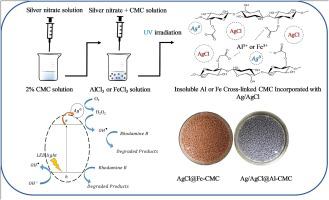Journal of Photochemistry and Photobiology A: Chemistry ( IF 4.1 ) Pub Date : 2020-04-22 , DOI: 10.1016/j.jphotochem.2020.112559 Hamed Heidarpour , Mortaza Golizadeh , Mohsen Padervand , Afzal Karimi , Manouchehr Vossoughi , Mohammad Hesam Tavakoli

|
In this work, a novel photoactive cellulose-based hydrogel was prepared by simultaneous AgCl formation and entrapment inside Al (III) and Fe (III) cross-linked carboxymethyl cellulose beads. Physio-chemical and optical properties of the synthesized composites were well characterized by X-ray diffraction (XRD) analysis, scanning electron microscopy (SEM), energy dispersive X-ray (EDX) analysis, elemental mapping, Fourier transform infrared (FTIR) spectroscopy, photoluminescence (PL), and diffuse reflectance spectroscopy (DRS). The photocatalytic activity of hydrogels was evaluated by the degradation of rhodamine B (RhB), as a model environmental pollutant. A comparative study showed that different cross-linkers resulted in different AgCl content, optical properties, and photocatalytic performance of hydrogel beads. Ag/AgCl@Al-CMC and AgCl@Fe-CMC composites exhibited remarkable photocatalytic performance (98 % and 87 % removal efficiency within 60 min, respectively) under visible light irradiation, and the effect of operational factors contributing to the photocatalytic process, including catalyst dosage, dye concentration, and initial pH was investigated. Scavenging experiments indicated that photo-induced hole and hydroxyl radical made a significant contribution to the degradation of RhB, and a plausible reaction pathway for the generation of major active species was proposed, according to the calculated band edge potentials of the photocatalysts. Reusability experiments revealed that the decolorization performance of the photoactive beads decreased after five repetitive experiments. This decline was attributed to the partial photocatalyst leaching from CMC polymeric network into the aqueous environment, evidenced by the results of ICP-OES analysis. The present study opens a new avenue for the development of hydrogel-based photoactive materials.
中文翻译:

Ag / AgCl光催化剂在交联的羧甲基纤维素微珠内的原位形成和包埋:一种新型的可见光诱导光催化光敏水凝胶
在这项工作中,通过同时形成AgCl并截留在Al(III)和Fe(III)交联的羧甲基纤维素珠粒内部,制备了一种新型的基于光敏纤维素的水凝胶。通过X射线衍射(XRD)分析,扫描电子显微镜(SEM),能量色散X射线(EDX)分析,元素映射,傅里叶变换红外(FTIR)光谱对合成复合材料的理化和光学性质进行了很好的表征,光致发光(PL)和漫反射光谱(DRS)。通过作为模型环境污染物的罗丹明B(RhB)的降解来评估水凝胶的光催化活性。一项比较研究表明,不同的交联剂导致不同的AgCl含量,光学性能和水凝胶珠的光催化性能。Ag / AgCl @ Al-CMC和AgCl @ Fe-CMC复合材料在可见光照射下表现出显着的光催化性能(在60分钟内去除率分别为98%和87%),并且操作因素对光催化过程的影响也包括在内。研究了催化剂用量,染料浓度和初始pH。清除实验表明,光诱导的空穴和羟基自由基对RhB的降解起了重要作用,并根据计算出的光催化剂的带边电势,提出了可能的反应途径,以生成主要的活性物种。可重复使用性实验表明,经过五次重复实验后,光敏珠的脱色性能下降。下降的原因是部分光催化剂从CMC聚合物网络浸出到水性环境中,这由ICP-OES分析的结果证明。本研究为水凝胶基光敏材料的开发开辟了一条新途径。




















































 京公网安备 11010802027423号
京公网安备 11010802027423号